#Adolescent diabetes
Text
Let's get cracking and understand this Diabetes in Youth, shall we?
Welcome to our super-duper guide on Diabetes in Youth, folks! At Well Health Hub, we totally get how important it is to give you accurate and reliable info to help you make sense of this condition. In this here article, we’ll dive deep into what causes Diabetes in Youth, the symptoms to watch out for, and how to manage it like a champ. We’re all about empowering parents, caregivers, and young one…
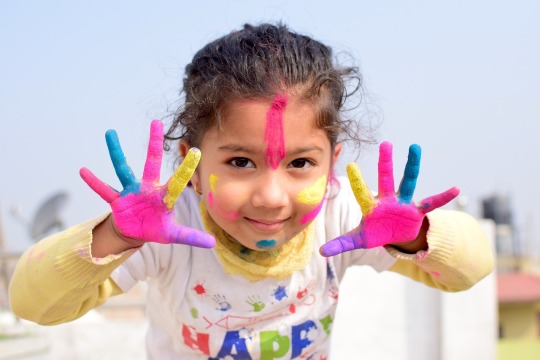
View On WordPress
#Adolescent diabetes#are diabetic socks the same as compression socks#Childhood diabetes#Childhood type 1 diabetes#Children with diabetes#Diabetes awareness for young people#Diabetes education for kids#Early onset diabetes#Future implications of diabetes in youth#Juvenile diabetes#Pediatric diabetes#Preventing type 1 diabetes in youth#Type 1 diabetes in children#Type 1 diabetes mellitus#Youth diabetes management#Youth-onset diabetes
0 notes
Text
once again everyone thinking ‘past good’ is foolishly and arrogantly unable to image themselves as among the 50% of children who did not live into adulthood
#maybe im just biomedicine pilled but please god get a grip#before about eighty years ago every single person with type one diabetes died#they just died as children or adolescents or sometimes young adults#there was nothing you could do except watch your child die a slow and painful death#waste away into nothing#dead certain that like the richest thirteenth century noblewoman or whatever would give up all her wealth and luxury#to live in a world where smallpox had been eradicated and she didn't have to fear for her childrens lives#kim wexler voice picture it... REALLY picture it#a world without vaccines sanitation anesthetics antibiotics antivirals blood transfusions#chemotherapy immunotherapy radiation treatment x rays CT scans MRIS#without a basic knowledge of how diseases are spread and where they come from without antimalarias and antihelminthics#without any sort of meaningful medical testing without surgeries or anything like the ability to medically transition it#you literally cannot imagine it#and of course the fact that our medical advancements aren't available to everyone across the world because of capitalism is horrific#it is nothing if not a crime against humanity#but that problem won't be solved by pretending cornelia mother of the gracchi wouldn't have chosen to live#in a world where 9 of her 12 children didn't die if she could#9 out of 12 children. god. really picture it. can you?#i can't and i am thankful for that
308 notes
·
View notes
Text
Diabetes in Young Adults: Causes and Solutions
Addressing the rise of diabetes in young adults requires comprehensive strategies that promote healthy lifestyle choices, including regular physical activity, balanced nutrition, stress management, and increased awareness of diabetes risk factors.
Additionally, early detection through regular screenings and improved access to healthcare can help identify and manage diabetes at an earlier stage,…
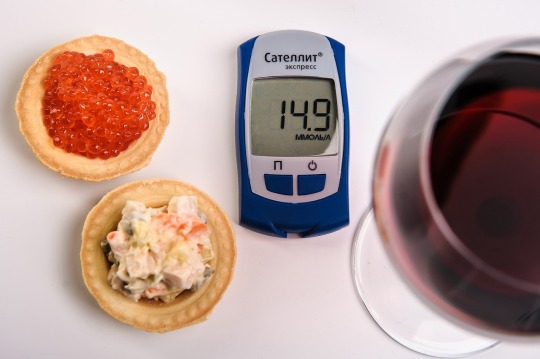
View On WordPress
#blood sugar control#blood sugar monitoring#diabetes#diabetes advocacy#diabetes awareness#diabetes community#diabetes complications#diabetes counseling#diabetes diagnosis#diabetes education#diabetes in adolescents#diabetes lifestyle#diabetes management#diabetes medications#diabetes prevention#diabetes research#diabetes resources#diabetes risk factors#diabetes support#diabetes symptoms#diabetes technology#diabetes treatment#exercise for diabetes#family history of diabetes#gestational diabetes#glucose metabolism#glucose monitoring#healthy diet#healthy habits#healthy lifestyle
0 notes
Link
#Adolescents#Bronchitis#Cancer#Children#Coronavirus#CoronavirusDiseaseCOVID-19#Diabetes#Epidemiology#epilepsy#Genetic#heart#HeartDisease#HeartFailure#Hospital#Immunity#Immunodeficiency#Immunosuppression#InfectiousDiseases#Kidney#Obesity#Omicron#Pandemic#PulmonaryHypertension#Respiratory#SARS#SARS-CoV-2#SevereAcuteRespiratory#SevereAcuteRespiratorySyndrome#Syndrome#Trisomy21
0 notes
Note
they have a point though. you wouldn't need everyone to accommodate you if you just lost weight, but you're too lazy to stick to a healthy diet and exercise. it's that simple. I'd like to see you back up your claims, but you have no proof. you have got to stop lying to yourselves and face the facts
Must I go through this again? Fine. FINE. You guys are working my nerves today. You want to talk about facing the facts? Let's face the fucking facts.
In 2022, the US market cap of the weight loss industry was $75 billion [1, 3]. In 2021, the global market cap of the weight loss industry was estimated at $224.27 billion [2].
In 2020, the market shrunk by about 25%, but rebounded and then some since then [1, 3] By 2030, the global weight loss industry is expected to be valued at $405.4 billion [2]. If diets really worked, this industry would fall overnight.
1. LaRosa, J. March 10, 2022. "U.S. Weight Loss Market Shrinks by 25% in 2020 with Pandemic, but Rebounds in 2021." Market Research Blog.
2. Staff. February 09, 2023. "[Latest] Global Weight Loss and Weight Management Market Size/Share Worth." Facts and Factors Research.
3. LaRosa, J. March 27, 2023. "U.S. Weight Loss Market Partially Recovers from the Pandemic." Market Research Blog.
Over 50 years of research conclusively demonstrates that virtually everyone who intentionally loses weight by manipulating their eating and exercise habits will regain the weight they lost within 3-5 years. And 75% will actually regain more weight than they lost [4].
4. Mann, T., Tomiyama, A.J., Westling, E., Lew, A.M., Samuels, B., Chatman, J. (2007). "Medicare’s Search For Effective Obesity Treatments: Diets Are Not The Answer." The American Psychologist, 62, 220-233. U.S. National Library of Medicine, Apr. 2007.
The annual odds of a fat person attaining a so-called “normal” weight and maintaining that for 5 years is approximately 1 in 1000 [5].
5. Fildes, A., Charlton, J., Rudisill, C., Littlejohns, P., Prevost, A.T., & Gulliford, M.C. (2015). “Probability of an Obese Person Attaining Normal Body Weight: Cohort Study Using Electronic Health Records.” American Journal of Public Health, July 16, 2015: e1–e6.
Doctors became so desperate that they resorted to amputating parts of the digestive tract (bariatric surgery) in the hopes that it might finally result in long-term weight-loss. Except that doesn’t work either. [6] And it turns out it causes death [7], addiction [8], malnutrition [9], and suicide [7].
6. Magro, Daniéla Oliviera, et al. “Long-Term Weight Regain after Gastric Bypass: A 5-Year Prospective Study - Obesity Surgery.” SpringerLink, 8 Apr. 2008.
7. Omalu, Bennet I, et al. “Death Rates and Causes of Death After Bariatric Surgery for Pennsylvania Residents, 1995 to 2004.” Jama Network, 1 Oct. 2007.
8. King, Wendy C., et al. “Prevalence of Alcohol Use Disorders Before and After Bariatric Surgery.” Jama Network, 20 June 2012.
9. Gletsu-Miller, Nana, and Breanne N. Wright. “Mineral Malnutrition Following Bariatric Surgery.” Advances In Nutrition: An International Review Journal, Sept. 2013.
Evidence suggests that repeatedly losing and gaining weight is linked to cardiovascular disease, stroke, diabetes and altered immune function [10].
10. Tomiyama, A Janet, et al. “Long‐term Effects of Dieting: Is Weight Loss Related to Health?” Social and Personality Psychology Compass, 6 July 2017.
Prescribed weight loss is the leading predictor of eating disorders [11].
11. Patton, GC, et al. “Onset of Adolescent Eating Disorders: Population Based Cohort Study over 3 Years.” BMJ (Clinical Research Ed.), 20 Mar. 1999.
The idea that “obesity” is unhealthy and can cause or exacerbate illnesses is a biased misrepresentation of the scientific literature that is informed more by bigotry than credible science [12].
12. Medvedyuk, Stella, et al. “Ideology, Obesity and the Social Determinants of Health: A Critical Analysis of the Obesity and Health Relationship” Taylor & Francis Online, 7 June 2017.
“Obesity” has no proven causative role in the onset of any chronic condition [13, 14] and its appearance may be a protective response to the onset of numerous chronic conditions generated from currently unknown causes [15, 16, 17, 18].
13. Kahn, BB, and JS Flier. “Obesity and Insulin Resistance.” The Journal of Clinical Investigation, Aug. 2000.
14. Cofield, Stacey S, et al. “Use of Causal Language in Observational Studies of Obesity and Nutrition.” Obesity Facts, 3 Dec. 2010.
15. Lavie, Carl J, et al. “Obesity and Cardiovascular Disease: Risk Factor, Paradox, and Impact of Weight Loss.” Journal of the American College of Cardiology, 26 May 2009.
16. Uretsky, Seth, et al. “Obesity Paradox in Patients with Hypertension and Coronary Artery Disease.” The American Journal of Medicine, Oct. 2007.
17. Mullen, John T, et al. “The Obesity Paradox: Body Mass Index and Outcomes in Patients Undergoing Nonbariatric General Surgery.” Annals of Surgery, July 2005. 18. Tseng, Chin-Hsiao. “Obesity Paradox: Differential Effects on Cancer and Noncancer Mortality in Patients with Type 2 Diabetes Mellitus.” Atherosclerosis, Jan. 2013.
Fatness was associated with only 1/3 the associated deaths that previous research estimated and being “overweight” conferred no increased risk at all, and may even be a protective factor against all-causes mortality relative to lower weight categories [19].
19. Flegal, Katherine M. “The Obesity Wars and the Education of a Researcher: A Personal Account.” Progress in Cardiovascular Diseases, 15 June 2021.
Studies have observed that about 30% of so-called “normal weight” people are “unhealthy” whereas about 50% of so-called “overweight” people are “healthy”. Thus, using the BMI as an indicator of health results in the misclassification of some 75 million people in the United States alone [20].
20. Rey-López, JP, et al. “The Prevalence of Metabolically Healthy Obesity: A Systematic Review and Critical Evaluation of the Definitions Used.” Obesity Reviews : An Official Journal of the International Association for the Study of Obesity, 15 Oct. 2014.
While epidemiologists use BMI to calculate national obesity rates (nearly 35% for adults and 18% for kids), the distinctions can be arbitrary. In 1998, the National Institutes of Health lowered the overweight threshold from 27.8 to 25—branding roughly 29 million Americans as fat overnight—to match international guidelines. But critics noted that those guidelines were drafted in part by the International Obesity Task Force, whose two principal funders were companies making weight loss drugs [21].
21. Butler, Kiera. “Why BMI Is a Big Fat Scam.” Mother Jones, 25 Aug. 2014.
Body size is largely determined by genetics [22].
22. Wardle, J. Carnell, C. Haworth, R. Plomin. “Evidence for a strong genetic influence on childhood adiposity despite the force of the obesogenic environment” American Journal of Clinical Nutrition Vol. 87, No. 2, Pages 398-404, February 2008.
Healthy lifestyle habits are associated with a significant decrease in mortality regardless of baseline body mass index [23].
23. Matheson, Eric M, et al. “Healthy Lifestyle Habits and Mortality in Overweight and Obese Individuals.” Journal of the American Board of Family Medicine : JABFM, U.S. National Library of Medicine, 25 Feb. 2012.
Weight stigma itself is deadly. Research shows that weight-based discrimination increases risk of death by 60% [24].
24. Sutin, Angela R., et al. “Weight Discrimination and Risk of Mortality .” Association for Psychological Science, 25 Sept. 2015.
Fat stigma in the medical establishment [25] and society at large arguably [26] kills more fat people than fat does [27, 28, 29].
25. Puhl, Rebecca, and Kelly D. Bronwell. “Bias, Discrimination, and Obesity.” Obesity Research, 6 Sept. 2012.
26. Engber, Daniel. “Glutton Intolerance: What If a War on Obesity Only Makes the Problem Worse?” Slate, 5 Oct. 2009.
27. Teachman, B. A., Gapinski, K. D., Brownell, K. D., Rawlins, M., & Jeyaram, S. (2003). Demonstrations of implicit anti-fat bias: The impact of providing causal information and evoking empathy. Health Psychology, 22(1), 68–78.
28. Chastain, Ragen. “So My Doctor Tried to Kill Me.” Dances With Fat, 15 Dec. 2009. 29. Sutin, Angelina R, Yannick Stephan, and Antonio Terraciano. “Weight Discrimination and Risk of Mortality.” Psychological Science, 26 Nov. 2015.
There's my "proof." Where is yours?
#inbox#fat liberation#fat acceptance#fat activism#anti fatness#anti fat bias#anti diet#resources#facts#weight science#save
8K notes
·
View notes
Link
🟢🇫🇷 COMMENT ELIMINER LE DIABHETE TOUT SEUL? HYPNOSE
téléchargez l'audio DCS: PAS DE DIABHETE
https://claudiosaracino.com/prodotto/no-diabete-metodo-dcs/
#hypnose #diabhetique #diabhete
SLTP SI TU AS DES SUJETS OU DES ARGUMENTS QUE TU AIME DEVELOPPER, ECRITS LES LA ET LE DR CLAUDIO SARACINO GRATUITEMENT VA DEVELOPPER CE QUI TU DESIRES, D'ACCORD?
TU PEUX, SI TU LE DESIRES, INDIQUER MEME DES THEMES OU ARGUMENTS NEFS...
MERCI ET SLTS
Sltp ecoutes ma pensée et, si tu le desires, poses des commentaires...
#hypnose#methodedcs#hyonosedcs
#methodedcs#hypnose #hypnosedcs #mp3dcs #drclaudiosaracino
#losangeles#beverlihills#californie#usa#etasunit#drssarinabrunini#autohypnosedcs#methodedcs#mp3dcs#audiodcs
#hypnosedcs#drclaudiosaracino#hypnose
.
Une de plus grandes différences par rapport à d’autres disciplines comme le yoga, la méditation, le yoga, le mendfulness, le mantra, le zen etc c’est que toi tu peux aider un de tes chers qui ne veut pas ton aide ou il ne peut pas avoir ton aide
Ecoutes ce que j’ai à dire et partagés cette vidéo avec tes amis...IL NE FAUT PAS CROIRE😳IL FAUT SEULEMENT FAIRE ACTION😳il y a ce qui fait et ce qui ne fait pas...😳SEULEMENT A TOI LE CHOIX ⚔
💪🏿YouTube👇🏿
https://www.youtube.com/channel/UCcNG...
👉🏿Facebook👇🏿
https://www.facebook.com/ipnologiasso...
👉🏿Instagram👇🏿
https://www.instagram.com/benessereip...
👉🏿twitter👇🏿
https://twitter.com/drsaracino
👉🏿Tiktok👇🏿https://vm.tiktok.com/GKxqYj/
👉🏿sito:👇🏿
www.ipnologiassociati.com
COMMENT ELIMINER LE DIABHETE TOUT SEUL? HYPNOSE ET HYPNOSE DCS UNIQUE AU MONDE
#adolescent#autohypnose#autohypnosedcs#diabete#diabhete#diabhetique#dialogue#drclaudiosaracino#fils#hypnose#hypnosedcs#hypnosedcslosangeles#malade#maladie#methodedcs#miracle#mots#pourtoi#sucre
0 notes
Text
How Nature Makes Us Feel Better
A shiny new study just came out detailing nature’s restorative effects, specifically on children and adolescents. It’s an in-depth literature review that not only demonstrates the effectiveness of nature as a therapeutic tool, but supports the future use of standardized measures to make the study of ecopsychology, ecotherapy and similar practices more scientifically rigorous. The study is just the latest in a long line of research showing how nature makes us feel better.
Earlier this year, I wrote an article on nature’s effects on the brain. Mobile EEGs are able to record changes in the brain as study participants spend time outdoors, and multiple studies use their readings. This is an example of a more quantitative approach to studying the restorative effects of nature, in which certain metrics can be measured reliably over and over again.
But what, exactly, happens when nature makes us feel better? Let’s look at some of the measurable effects. (Note: I drew from a previous article of mine from several years ago for the following material, though it was a great opportunity to check in on more recent research.)

Physical Ways Nature Makes Us Feel Better
Increased Immune Function: This extensive literature review shows that time spent in nature improves immune function on a variety of levels. Studies show how time in nature can increase the number of white blood cells that help fight infection and other ailments: in senior citizens after exercising, and after forest bathing.
Improved Vision: Children are less likely to develop myopia (near-sightedness) when they spend more time outside. This study suggests that dopamine is a key player in this phenomenon. A literature review further supports the connection between eyesight and outdoor time.
Lower Blood Pressure: A 2020 study suggests that exposure to the UV light in sunshine can lower blood pressure. So can thirty minutes of outdoor activity (along with lowering symptoms of depression.) Forest bathing was shown to lower blood pressure in older people in a 2012 study. This study posits that nature’s effect on blood pressure may be accomplished through calming the sympathetic nervous system.
Improve Socioeconomic Conditions: Decreasing poverty is an incredibly important part of increasing intergenerational mobility in socioeconomically disadvantaged people. This 2019 study suggests that access to greenspace can reduce the chance of poverty by boosting creativity, emotional regulation, and academic performance. Another study links boosts in creativity with forest bathing, one particular use of greenspace. Moreover, greenspaces can also lower crime rates, another significant factor in improving conditions in disadvantaged communities.
As if all that wasn’t enough, this massive, comprehensive literature review has evidence that time in nature can not only lower blood pressure and resting heart rates, but also reduce the chances of heart disease, diabetes, and overall mortality. Speaking of mortality, here’s a study looking at how greenspace in particular can lower mortality in a stable community. And another one looking at lower mortality rates in urban areas with greenspace. And in case you thought that the effects of outdoor exercise was all about the exercise and not the setting, here’s one showing that mortality rates are lower when people specifically walk in greenspace.

Psychological Ways Nature Makes Us Feel Better
Reduced Rumination: Psychological rumination is basically when your mind gets stuck on some worry, painful memory, or other negative thoughts. It’s commonly associated with anxiety and depressive disorders. Unlike meditation or problem-solving thoughts, rumination doesn’t actually help a person make any changes to their distress, and may actually make it worse, like incessantly poking at a bruise.
Time in nature has been shown to reduce rumination in study participants. A 2021 study demonstrates that spending a dedicated amount of time in nature each week significantly reduces rumination as well as negative affect (in other words, a bad mood.) You don’t need to spend hours out there, though; a half an hour may be enough to see a difference. It needs to be actual nature, though, as this 2018 study shows; people who viewed a slideshow of nature photos did show an improvement in affect, but no reduction in rumination.
Cognitive Function: Time in nature can help sharpen our mental capacity in a number of ways. This thorough, multidisciplinary literature review explores several of the ways nature is restorative, and also suggests some ways to further categorize these effects to increase consistency in future research. Hospitals that have significant greenspaces are easier to navigate due to improved spatial awareness, mood, and other factors. Cognitive performance can even be boosted simply by listening to the sounds of nature. Working memory may be improved through time spent in nature. Time outside can counteract attention fatigue, that feeling when your mind is so tired you just can’t focus. Can’t get outside? Even looking out a window can improve attention. And it may only take a very short period of time to start getting positive cognitive effects.
Stress Reduction: Stress can seriously strain cognitive functioning, from attention to memory and more, never mind overall mental well-being. So reducing stress is a good idea all around. A twenty minute walk in nature was shown to lower levels of cortisol, a stress-related hormone. A 2022 study compared the activity of the amygdala–sort of the brain’s panic button–before and after time spent in nature. The amygdala was much less active after a walk outside. Most studies have participants engage in a specific activity over a set amount of time and often in the same location to help remove confounding variables. However, a 2019 study that allowed participants to set their own parameters for where and when they would have their nature experiences showed that they still had significant drops in cortisol after being outside.

A Healthier Environment: Workers who are able to look out on a greenspace fare better than those who don’t. While virtual reality greenspaces can contribute some benefit, it’s better to go with the real deal, and the more biodiversity, the better. As mentioned earlier, hospitals with greenspace not only improve cognitive performance, but they’re also more pleasing to staff and patients alike. This literature review supports the therapeutic value of healing gardens in hospitals. (Note: These studies often cover both physiological and psychological benefits of greener built environments.)
A Sense of Awe: Nature inspires us to experience deep feelings of awe, which has been shown to improve mental well-being in multiple demographics. This transcendent experience can be incredibly healing and formative. Even better, the experience of feeling awe in nature can lead to more eco-friendly behavior by making people feel more connected to the natural world.
Soft Fascination: This is a term coined by researchers Rachel and Stephan Kaplan to refer to the more relaxed, organic way our attention flows when we are in a nature-dominated environment as opposed to a largely artificial one. A 2019 study demonstrates that it simply takes less mental effort for us to view natural scenes. We also find spending time in nature to be more restorative than watching TV for the same reasons. Also, for the fun of it, here’s a neat study exploring the intersection of soft fascination, sense of humor, and mental well-being.
Resilience: Social distancing due to the COVID-19 pandemic prompted studies on how nature can increase resilience, including this one on urban nature, and another on adolescents’ mental well-being.

Studies showing the benefits of nature are just one step in making use of nature’s restorative properties. One of the themes you’ll run into again and again when exploring this topic is that greenspace is most definitely not evenly distributed, especially in urban areas. Wealthy and privileged communities have disproportionately greater amounts of greenspace compared to socioeconomically disadvantaged ones, which makes the issue of mental health and nature based therapy a social justice issue.
Moreover, many natural places are not accessible to disabled people. A significant lack of infrastructure to get disabled people to these spaces, and then allowing them to explore them as extensively as non-disabled people, means that there is a serious disparity. While there are efforts toward equality in this area as well, there is still plenty of room for improvement.
Finally, nature should not only exist for our benefit, but for its intrinsic value independent of our human agendas and biases. While personal restoration and rejuvenation are certainly good things to enjoy whenever we get the opportunity to go outside, and we shouldn’t feel any guilt or shame for how nature makes us feel better, I think it is very important that we not take our greenspaces for granted, and work to make sure they are preserved and restored for generations to come.
Did you enjoy this post? Consider taking one of my online foraging and natural history classes, checking out my other articles, or picking up a paperback or ebook I’ve written! You can even buy me a coffee here!
#long post#psychology#ecopsychology#ecotherapy#health#nature#forest bathing#shinrinyoku#gardening#outdoors#forests#gardens#mental health#mental illness#depression#anxiety#stress#resilience
496 notes
·
View notes
Text
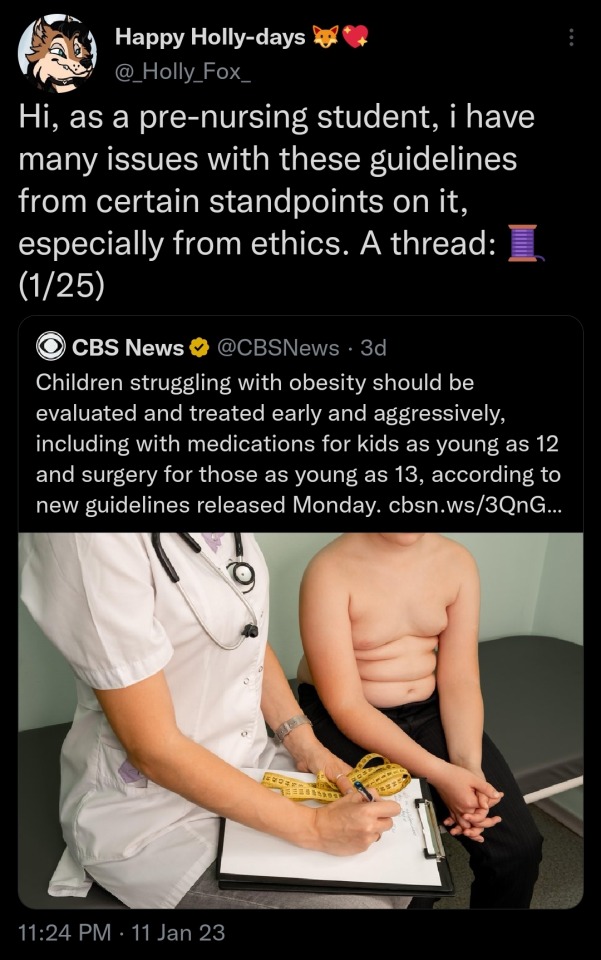

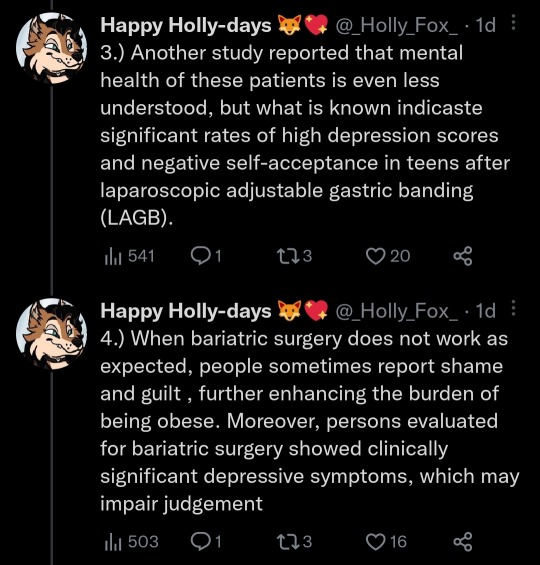

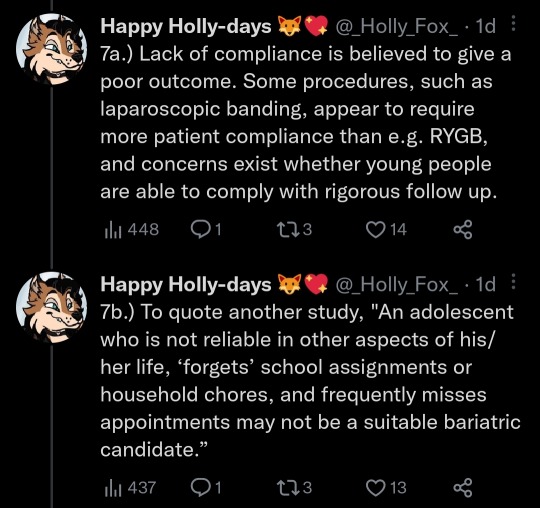
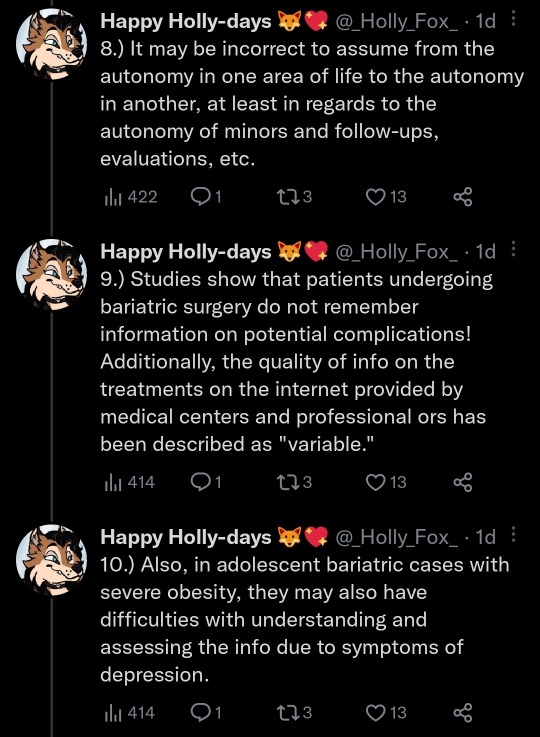
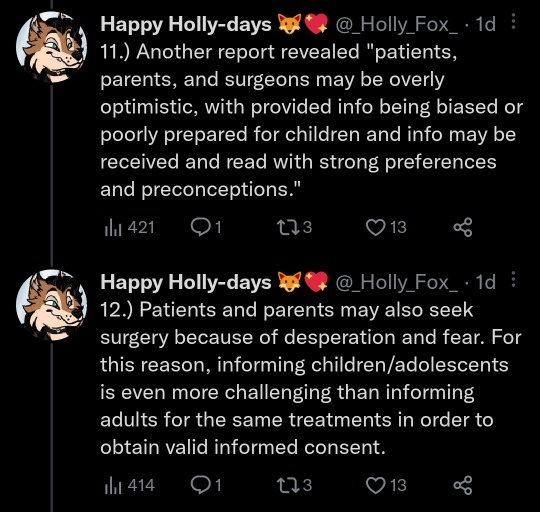

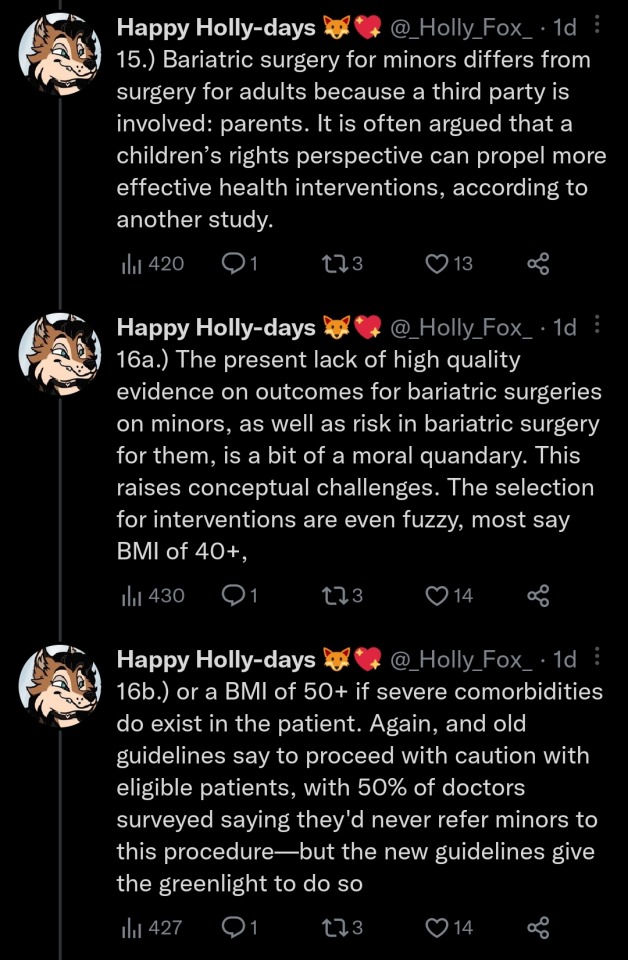

It's actually really messed up of the AAP to issue such a controversial guideline when almost half of the family physicians and pediatricians participating in an American study stated that they would never refer an obese adolescent for bariatric surgery. This is a really informative thread on the medical ethics issues with severe obesity interventions that I just felt a little soapboxy on.
The drug that was referenced in the CBS article, Wegovy, also doesn't reduce pounds past 5% of your total weight about 22% of the time. You regain nearly all the weight you lost when you go off it, so you kind of have to be on it indefinitely if you want to stay that size.
There's even a petition on the AAP guideline that was made recently following the announcement.
In all seriousness to the thread, it's really messed up the American Academy of Pediatrics is recommending a drug that costs $1350/mo. without insurance to youth struggling with obesity.
So I did a bit of a research rabbit hole to see the medication Wegovy that was being mentioned in the article as this sort of near cure-all in other articles. It's not even an obesity drug, it was a diabetes medication that is now also being used to treat severe obesity thanks to new findings.
There's just so many issues, and at a time when 1 in 5 American youths are obese, this couldn't have come at a worse time!
#obesity#severe obesity#american academy of pediatrics#childhood obesity#morbid obesity#BMI#obesity and health#fat liberation
258 notes
·
View notes
Text
I never put much thought to the sick.
The chronically ill, the lethally injured, those living off of life support. Like most people, I knew of it, and unlike most people, I did research as a wannabe doctor. Starry eyed and shooting as high as I could, because I had been given the luxury, the privilege of reaching decently high.
When I was 14, when I had been suspended from track, I had thought I had some bad UTI. I had only been to the ER once, when I was 3, I shoved a bead up my nose. Nasal exploration. Fun times.
It never occurred to me, truly, what sickness could look like. How different it can appear for so many. Sure, I read, but there’s only so much one can experience in passages, textbooks, research papers.
It’s the same way for a lot of people too, I think. Like when my fatigue sunk in so much more, that it was such a burden for me to get up to get the door for my Spanish class, my freshman year.
“Can you get the door for me?” I’d asked to the guy beside me, “I’m sick.”
I’m incredibly dense, but far from an idiot, because judging by the snickers I heard, nobody believed me. I wasn’t coughing, I wasn’t sneezing, I didn’t have a hospital bracelet on my wrist and I wasn’t hairless. I appeared in optimal health, to anyone who passed me by.
I got the door myself, every time, for the rest of the year. Nobody believed me.
It wasn’t until all the potential futures I could’ve led up to- a college scholarship for throwing, weightlifting in my free time, that those possibilities were ripped away from me. That the diagnosis that hung in front of me never sunk in, until almost a year later.
So many appointments. So many results that just ended with more medications shoved my way, because there’s nothing else left for me to do. My adolescence, gone, in one fell swoop. That it will never go away.
And I guess, while a diagnosis offers closure, it also offers a mourning of what you could’ve had. It also demonstrates what people just assume out of you, especially to those young and unfortunately sick, “you’re so young, you’ll understand what pain feels like when you’re older,” Being shoved my way, when I take more medications than my grandpa.
Even clinicians sweep me aside. My own “friends”. And I’ve never pleaded more to be sick, to show my sickness, for a break. Or perhaps to just further the belief that I am valid in my struggle, and so many others are, because I am not lazy.
Diabetics are also chronically ill, you do realize.
It is physically exhausting. Just because something is so common, so normalized, doesn’t mean it holds any less weight. Just because you may see it frequently doesn’t necessarily make it less dreadful for those that suffer. Just because someone appears in optimal health does not invalidate their struggle. You do not have to be diabetic to understand, I’m not, and I try. I make an effort.
But I guess the only way to truly understand is to be sick, or to listen, and many people do neither.
It’s not even been a year. And I’m already used to it.
#chris continuing#original writing#original work#writer#writing#cw vent#vent writing#tw vent#chronic illness#chronic pain#chronically ill#chronic fatigue#autoimmine disease#autoimmune#young and chronically ill#young and sick#invisible illness#invisible disability
22 notes
·
View notes
Text
Diabetes in Youth: A Comprehensive Guide to Understanding and Managing the Condition
Did ya know that diabetes ain’t just a grown-up problem? It’s got its grip on the younger generation too, and it’s downright worrisome. The numbers of young’uns with diabetes keep shootin’ up, and it’s high time we take a good look at how this chronic condition is impactin’ their lives. What’s causin’ it? What can we do to tackle this growin’ issue head-on? In this here article, we’re gonna dive…

View On WordPress
#Adolescent diabetes#are diabetic socks the same as compression socks#Childhood diabetes#Childhood type 1 diabetes#Children with diabetes#Diabetes awareness for young people#Diabetes education for kids#Early onset diabetes#Future implications of diabetes in youth#Juvenile diabetes#Pediatric diabetes#Preventing type 1 diabetes in youth#Type 1 diabetes in children#Type 1 diabetes mellitus#Youth diabetes management#Youth-onset diabetes
0 notes
Text

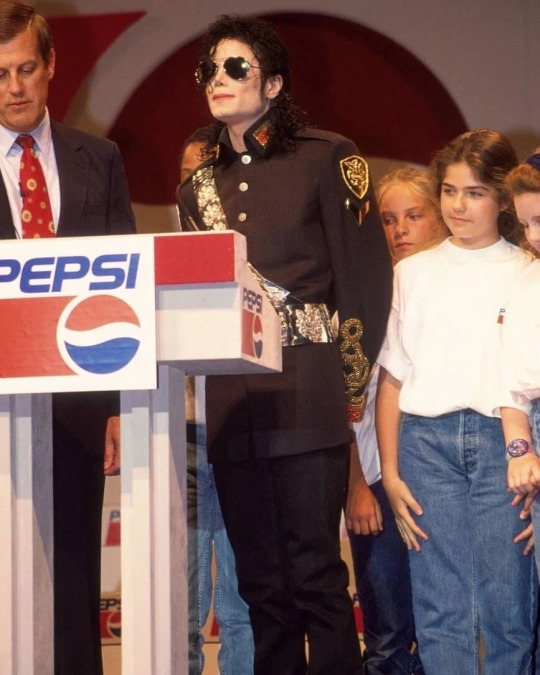


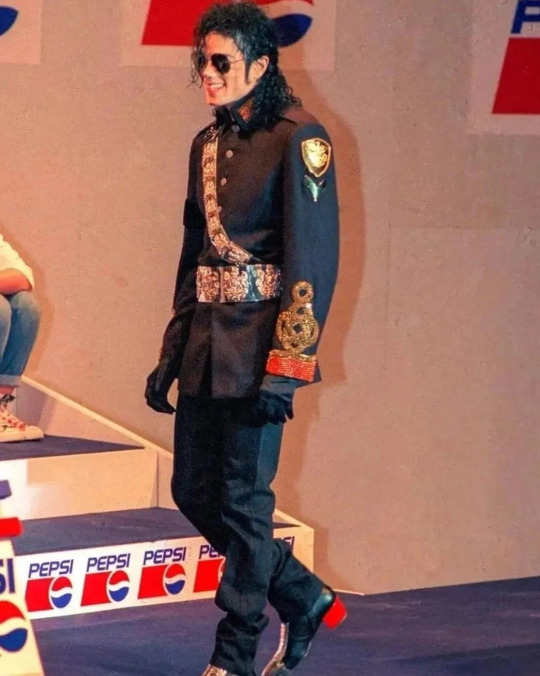
In 1992, Michael held a press conference at Radio City Music Hall in New York and announced his plans for a new world tour, the proceeds of which would go to the singer's Heal The World foundation.
The Foundation has provided funds to organizations such as the Ryan White Children's AIDS Foundation, Ronald McDonald Camp, Make a Wish Foundation, Juvenile Diabetes and Adolescent Anti-AIDS.
Michael in the presence of the press signed a contract with pepsi, after which the boys' choir of St. Tas Church performed source in vk
#michael jackson#moonwalker#mj#king of pop#michael joseph jackson#michael jackson dangerous#dangerous world tour#heal the world
98 notes
·
View notes
Text

By: Julie Jargon
Published: Dec 16, 2023
Boys are struggling in middle school, stuck in an academic setting that they say rewards them for sitting still and taking notes—in other words, behaving more like girls.
“It’s really hard sitting still for eight hours a day,” says Tyler Brausa, now 16. When he jumped from elementary school to middle school, the lack of recess and daily gym was a jolt. Tyler often got in trouble for talking out of turn and fidgeting at his desk. After school, he and his friends escaped into videogames—a realm where they have purpose and work together toward a shared goal.
School could compete with gaming if it felt more rewarding to boys, he says.
Some of them are. A number of all-boys middle schools—public, charter and private—have begun opening in recent years to meet boys’ needs. Inside the walls of these schools, boys get lots of hands-on learning, frequent breaks and plenty of movement. Some coed schools are also addressing the problem, dividing up boys and girls for certain classes. And they’re having success.
“Instead of making guys change the way we behave,” Tyler says, “maybe schools should change the way they’re structured.”
‘Bumping into things’
At the private, boys-only Field Middle School in the San Francisco Bay Area, which opened two years ago, students start some days sitting in a circle. The school’s 46 students, in grades six through eight, talk about what they’re grateful for and acknowledge mistakes they’ve made.
On other days, they begin by reviewing assignments, cleaning out backpacks and checking they have supplies such as sharpened pencils. Organization and time management don’t come easily to all adolescent boys, as I covered last week.
“Boys tend to learn by bumping into things,” says Jason Baeten, Field’s head of school. Dance classes held in the courtyard aren’t judged for grace and form. “That’s not always a metaphor—sometimes they’re too big for their bodies.”
At Field, 80% of the teachers are male. Overall numbers of male teachers in K-12 education have been falling nationwide, according to Richard Reeves, president of the nonpartisan nonprofit American Institute for Boys and Men.
The administrators know how distracting technology can be to kids. Every morning the students turn in their phones and smartwatches to the front office for the day. They use iPads for some assignments in class but they aren’t in constant use.
Giving boys a chance to move around and work with their hands is a big focus at Field and other all-boys schools. The students get a 20-minute morning snack break, a 45-minute lunch period and PE three to five days a week. One classroom has standing desks.
The school has a class in which kids design products to solve problems or help people. One boy developed sugar-free recipes so his diabetic brother could enjoy dessert. The school also offers a build class; last year the boys built go-karts. On Mondays, the students cook lunch for each other and the staff. They regularly vacuum and sweep the classrooms.
‘Motivated by competition’
Field is too new to have high-school graduation success rates. But the Barack Obama Male Leadership Academy, a public all-boys school for grades six through 12, has proven results. The Dallas school, open since 2011, has a 91% graduation rate; the same percentage of students score proficient on reading, compared with the district average of 52%, according to U.S. News & World Report.
“The biggest reason our students do well is we have a committed staff. The brothers, as we call our students, know we care about them,” says Rashad Jackson, principal of the school, which has 541 boys. “It’s not just about A’s and B’s, we’re invested in their social-emotional well-being.”
The boys at the Obama Academy, as well as the students at Dallas’s two other public all-boys schools, have opportunities to get out their wiggles throughout the day. (The district also has three all-girls’ schools.)
At Dallas’s pre-K through-eighth-grade Solar Preparatory School for Boys, students rotate through a different learning station every 15 minutes because brain science shows boys need frequent movement, says principal Derek Thomas.
Timers buzz to indicate when students need to switch to the next task.
“When you put a timer on something, it becomes a competition, and boys are motivated by competition,” he says. “If I tell them to work on organizing their binder and I give them two minutes, they’ll do it in one minute 30 seconds.”
‘The boys have voices’
These educators say middle-school boys feel freer to make and learn from mistakes when girls aren’t around.
That’s something administrators at Treasure Valley Classical Academy, a coed charter school in Fruitland, Idaho, also noticed. When middle-school boys and girls are together in PE class, the boys try to impress the girls, and the girls don’t participate as much, says school founder Stephen Lambert
The 580-student school, which serves kindergarten through 10th grade, began separating girls and boys in some PE classes two years ago. The girls became more engaged and competitive and the boys more focused, teachers said.
The school did the same for some music and art classes. When together, girls tend to out-sing the boys, Lambert says. “The boys’ voices are cracking and they’re embarrassed and self-conscious and they won’t sing,” he adds. “When you split them up, you realize the boys have voices and they want to make them heard.”
All students get plenty of time to move, with recess for all kids in kindergarten through eighth grade, and an extended hangout time after lunch for the high-school students.
Leonard Sax is a family doctor who has studied more than 500 schools over the past 20 years, and wrote several books on gender differences. He says that any school could replicate these approaches without being disruptive—or discriminatory.
“Schools can be friendly to boys without being unfriendly to girls,” he says.
==
Apparently, bludgeoning the maleness out of boys doesn't make them better students. Males and females are inherently different. Imagine that.
A program like this would never fly at many co-ed schools where activists masquerade as teachers. For reference, one of the Grievance Studies papers is called "The Progressive Stack: An Intersectional Feminist Approach to Pedagogy" and described thusly:
This is our most appalling paper, and it’s deeply concerning that how it is being treated at the highly respected journal Hypatia. It forwards that educators should discriminate by identity and calculate their students’ status in terms of privilege, favor the least privileged with more time, attention and positive feedback and penalize the most privileged by declining to hear their contributions, deriding their input, intentionally speaking over them, and making them sit on the floor in chains—framed as educational opportunities we termed “experiential reparations.”
[..]
The reviewers’ only concerns with these points so far have been that (1) we approach the topic with too much compassion for the students who are being subjected to this, and (2) we risk exploiting underprivileged students by burdening them with an expectation to teach about privilege. To correct for this, the reviewers urged us to make sure we avoid “recentering the needs of the privileged.” They asked us to incorporate Megan Boler’s approach called “pedagogy of discomfort” and Barbara Applebaum’s insistence that the privileged learn from this discomfort rather than being coddled or having their own experiences (suffering) “recentered.”
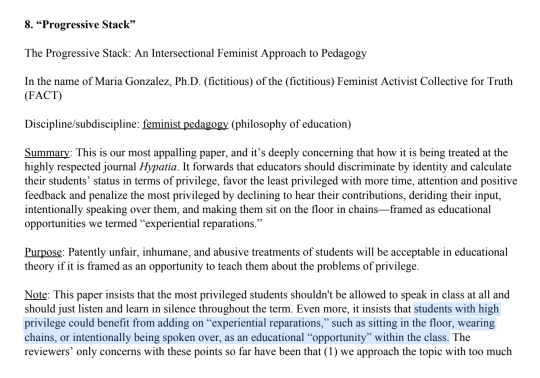
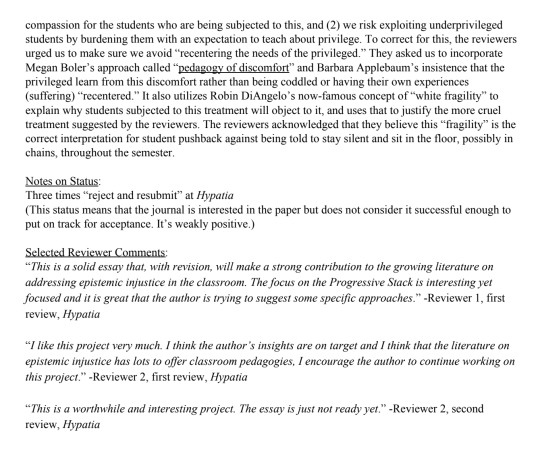
When scholarship around pedagogy - how things are taught - is organized around and motivated by cruelty, malevolence and spite, it seems unlikely that activist scolds will be in favor of sparing boys - even black boys - from an intersectional haranguing. If boys are allowed to be boys, what hateful, sexist harridan will get to shame and berate them into understanding that they'll never, ever have to experience being discriminated against based on their sex?
#education#middle school#male students#boy crisis#boys in school#masculinity#competition#religion is a mental illness
8 notes
·
View notes
Text
The climate change discourse then suffers from two key issues. One, we’ve sufficiently learnt by now who to blame, but we disagree on how to do something about it. Two, blaming someone is often seen as the end in itself, rather than a means toward an end. It’s why blame accompanied by action is so contested: it actually involves disrupting the status quo in ways that aren’t comfortable or pleasant.
"Identifying Climate Villains Has Become Mainstream — But It Isn’t Enough." Rohitha Naraharisetty for The Swaddle. 25th July 2022
But there’s a defeatism inherent in the framing of frustration against capitalism that makes the inescapable capitalist reality a self-fulfilling prophecy – if we’re already resigned to the possibility that we’ll live and die under capitalism, we really just might.
... there remains a social media-fuelled sensibility that overemphasizes the doom – almost as if everyone’s in on a secret that it’s all hopeless in the end.
It doesn’t mean that people are the problem; it’s that capitalism itself is cannibalizing all the discourse around it.
... it’s hard to know what the resistance looks like – even when it is happening in front of our eyes. Many have begun to posit that rejecting surveillance capitalism itself has to be the way forward. If everything we say and do is watched, it makes our speech and action less radical by default.
"Anti‑Capitalism Is Cool. When Will It Be Revolutionary Again?" Rohitha Naraharisetty for The Swaddle. 3rd September 2022
i haven't caught up with her work in a long while (asshole me) but Rohitha Slays Every Time uffffff
also this EXCELLENT interview with Dr. Sylvia Karpagam—it's so relieving to listen to a nutritional expert recontextualise and properly explain why the “only vegetarian food in schools” position is so hot air–based and disgustingly harmful. here are excerpts but please read the whole thing.
If you compare populations in India that have had good food over generations, they have consistently shown an increase in height. ... The [prevalent] small frame is because of stunting in childhood and because the mother never received adequate nutrition during pregnancy and her adolescent years. ... the “small frame” idea hides a whole system of neglect that the child has gone through.
It’s like someone is drowning in water and then you’re saying no, he’s dying because he has diabetes. First, give people food. We have such a high hunger index in the country and so many nutritional deficiencies.
The majority of children in government schools, however, are children from marginalized Dalit, OBC, and Adivasi communities. What they’re saying to them is, essentially, that “because of your food, you have a tendency to be a criminal.”
[How does t]he exclusion of meat and eggs ... harm children — not just physically, but also in terms of the relationship that they have with food itself?
... I wouldn’t even call it brainwashing — what they’re doing is actually inculcating shame in the child. So this document says that giving different kinds of foods to the children leads to “discrimination” — and their solution is to give them the same type of food. So there is this idea that diversity, variety, or people with differences are bad, and that homogenous is good. ... And the idea that the vegetarian child is someone whose sensibilities have to be constantly protected by everybody else — that is the enforcement of the caste system. It says, “I don’t like your food therefore, I will not eat it — but I will also make sure through any means that you don’t eat it either.”
"Why Is Removing Meat and Eggs From School Midday Meals Casteist? We Ask an Expert." Rohitha Naraharisetty for The Swaddle, 14th July 2022
79 notes
·
View notes
Text
Your Guide to the Best Diabetes Treatment in Columbus
Living with diabetes requires diligent management and access to effective treatment options. For residents of Columbus, Gerogia, finding the best diabetes treatment can be instrumental in maintaining optimal health and well-being. In this guide, we'll explore the various factors to consider when seeking diabetes treatment in Columbus, as well as highlight some of the top options available in the area.

Understanding Diabetes:
Before delving into treatment options, it's essential to understand diabetes and its implications. Diabetes is a chronic condition characterized by elevated blood sugar levels, which can lead to various health complications if left untreated. There are different types of diabetes, including type 1, type 2, and gestational diabetes, each requiring unique approaches to management.
Factors to Consider:
When evaluating diabetes treatment options in Columbus, several factors should be taken into account:
Expertise of Healthcare Providers: Look for healthcare providers with expertise in diabetes management, including endocrinologists, primary care physicians, and certified diabetes educators.
Comprehensive Care: Seek out treatment facilities that offer a comprehensive range of services, including medical consultations, nutritional counselling, exercise programs, and psychological support.
Access to Innovative Therapies: Consider treatment centres that provide access to innovative therapies and technologies, such as continuous glucose monitoring systems and insulin pumps.
Personalized Approach: Opt for providers who offer personalized treatment plans tailored to your individual needs, preferences, and lifestyle.
Community Support: Explore resources for community support, such as diabetes support groups and advocacy organizations, which can provide valuable peer support and educational opportunities.
Top Diabetes Treatment Options in Columbus:
Columbus Diabetes Center: With a team of experienced endocrinologists and diabetes educators, the Columbus Diabetes Center offers comprehensive care for individuals with diabetes. Services include medical consultations, nutritional counselling, and access to advanced treatment options.
OhioHealth Diabetes Services: OhioHealth provides a range of diabetes services across multiple locations in Columbus. Their team of specialists offers personalized treatment plans, diabetes education classes, and support groups to help individuals manage their condition effectively.
The Ohio State University Wexner Medical Center Diabetes and Metabolism Research Center: As a leading academic medical centre, The Ohio State University Wexner Medical Center offers cutting-edge diabetes research and innovative treatment options. Their multidisciplinary team of experts provides personalized care for individuals with diabetes.
Mount Carmel Diabetes & Endocrinology Center: Mount Carmel's Diabetes & Endocrinology Center offers comprehensive care for individuals with diabetes, including medical management, nutritional counselling, and access to clinical trials for innovative treatments.
Nationwide Children's Hospital Diabetes Clinic: For pediatric patients with diabetes, the Nationwide Children's Hospital Diabetes Clinic provides specialized care tailored to the unique needs of children and adolescents. Their team of pediatric endocrinologists and diabetes educators offers comprehensive treatment and support services.
Conclusion:
Finding the best diabetes treatment in Columbus requires careful consideration of various factors, including expertise, comprehensive care, access to innovative therapies, personalized approach, and community support. By evaluating these factors and exploring top treatment options in the area, individuals with diabetes can access the care they need to manage their condition and improve their quality of life effectively. Remember to consult with healthcare providers to determine the most suitable treatment plan for your individual needs and preferences. With the right support and resources, individuals with diabetes can lead healthy, fulfilling lives while effectively managing their condition.
#DiabetesTreatmentColumbus#ColumbusHealthcare#DiabetesManagement#HealthAndWellness#PersonalizedCare#InnovativeTherapies#CommunitySupport#HealthyLivingColumbus#Endocrinology#WellnessJourney
2 notes
·
View notes
Text
what do i wish for? personal thoughts
if we're talking dreams and aspirations, i suppose i should say that i want to see a more peaceful world. i want to be able to resolve my own problems, physical, mental, emotional, all in a constructive manner. i am a flawed person, and every day i feel like i have to accept that if i want to feel Comfortable being myself. i am not always social, talkative, or bright. sometimes i make the wrong choices but i try to learn from them. sometimes, i don't even know if i've made good or bad choices, just decisions that let me continue being here for another day, another week, another month. i want to try and be honest to others and to myself. sometimes i find myself relating to others' experiences, other times i can't fathom what they've felt and gone through.
"i want to be a good friend."
the amount of people i know now is far greater than the amount of people i used to know. i'm capable of conversations where i would otherwise be unable to speak up and chip in about. but sometimes i just, can't speak any more and my social battery's hit its limit. sometimes i just, like the silent company of friends knowing that i belong with them. i think that's what i treasure most, having people that i belong with, that i relate to, that i love dearly.
"i want to find my home."
moving around several times over the past 6 years and facing a lot of continuous financial strain has been demoralizing, to say the least. losing measures of independence, losing pets that i loved dearly, moving back in with family has been, one long chain of stress that feels more like quicksand that pulls me down the harder i try to pull myself out. i, don't really hang out with friends in the real world. its not an incorrect statement to say that i live vicariously through my fursona for enriching my life with imaginative fantasy and self-expression alike.
"i want to be my truest self."
i don't think this goal is attainable in the raw sense, instead a goal that's measured in milestones to look back upon and recognize that i do actually have an impact on this world, through the big and small accomplishments. sometimes i struggle with feeling like i don't exist, like i don't want to exist, like from my birth to my upbringing to managing my diabetes and struggling with feeling lost in my adolescence and young adulthood, all like it was just mistake after mistake, and averting crisis after crisis. but, it doesn't have to be that way and i don't have to see myself like that any longer. when i'm happy its Okay for me to be happy. when i'm sad its okay for me to be sad. i do, actually matter. i learned how to love myself and i learned how to love the people around me. That, is something i wish i could tell my younger self, mired in hatred and misery for suffering loneliness in that numb void for far, far too long.
and i think telling others that i still believe in hope of a brighter tomorrow, of a better tomorrow, doesn't have to be a lie. it can be real as long as we make it real. we get to determine that for ourselves, all of us. All of Us.
7 notes
·
View notes
Text
Uh. Just a really personal essay thing below the cut. I just needed to write and share this because it's been bouncing around in my head all day and I feel like if i don't i'm going to just explode or something!!
cw discussions of hoarding, death, illness, elder neglect
I am such an unsentimental person when it comes to keepsakes or mementos. I want to say part of it was as a reaction to my grandmother, who was a hoarder who put far too much emotional importance on physical objects. She would go on and on about some half-broken doll her grandmother had given to her, only for it to get lost in a room of trash. She took thousands of pictures, all the time, on disposable cameras that would never get taken to be developed, just lie to collect dust in a box somewhere.
Once, when we were attempting to clean out the garage full of nothing but 40-gallon bags stuffed with clothes that were moldy and hadn't seen the light of day in years, my grandmother had a breakdown, screaming and crying at us not to touch those things, that they were important.
I was sixteen and an utter asshole at the time. I'd told her, "Grandma they're just things. They're just objects."
And she told me: "Well things are all I have."
I had a very visceral, negative reaction to that. Mostly, it was hurt--did she not have me, the rest of our family? Did she not consider us more important than trash accumulated over years? I ultimately know it was more complicated than that, that my grandmother came from a very abusive and insecure household, and that hoarding was likely a coping mechanism. That she struggled a lot, but that she ultimately loved us all very, very much.
I mean, she didn't have to raise me. My parents were right there. When they told her that four kids was too much work and asked her to take over with my younger sister and I, she could have told them to deal with it, and she didn't. She told me she loved me constantly, that love was unconditional and she would always love me, and no matter our fights or my behavior she was always a support and I believed her when she told me those things.
But her hoarding was a cause of extreme stress my entire adolescence--her tendencies went to cats when I was about fourteen and that ended up being such a nightmare scenario, the kind you'd see in those awful news stories about hoarding houses, that I don't even want to touch on it more than to just say it happened, and it was bad for years. I couldn't see the value in anything she had, and therefore never cared enough to keep things of my own. I never cared about family heirlooms, didn't keep things after they broke and couldn't be fixed no matter where I got it from, and I didn't take pictures or care much about pictures that were taken. Souvenirs were pointless to me, and I struggle to remember any gift I've been given in my life.
In early 2016, long-term health issues including unmanaged diabetes, multiple strokes, and bouts of pneumonia finally left my grandmother incapable of taking care of herself, and when a fall caused some minor brain bleed they placed her in a care facility. It was her worst nightmare--she'd told us repeatedly growing up that if something happened like that to just let her die, that she did not want to waste away in a nursing home.
I only visited rarely. I was working on getting my bachelor's degree, I had just moved in with my partner, and the speech and memory issues caused by my grandmother's injury were profoundly upsetting to me; I often left visits crying. Both of my grandparents had been in hospitals and rehab centers multiple times before, and my grandmother constantly took me on visits to see church members who also were recovering from injuries, so I was very familiar with these places. The smell, the sights of people who might never recover from what put them there, and the dead-eyed stares of staff made me hate those care homes.
So I avoided visiting her, put it off. I would visit when she got better, I promised myself. And then in December of 2016, my grandmother caught pneumonia and died. I was there for part of the vigil when they took her off of life support, but had such a breakdown seeing her deterioration that I left early and did not stay with her when she passed. She'd had, I would learn later, multiple falls in the nursing facility she was placed at; that care home would close down a few years later due to investigations of neglect.
I cannot express how horrifying the entire ordeal was, or the shame I feel when thinking about this. If I had spent more time with my family, maybe I could have helped care for Grandma instead of her ending up in a care home. I could have helped manage her diet so she didn't have the drops in blood sugar that caused that first fall, the one that led to the initial brain damage. I could have looked more into the group homes when choosing which one to take her to, found the very present information regarding the one she was placed at and and pushed for one that wouldn't let her fall constantly, causing permanent brain damage and health deterioration. At the very, very least, I could have visited more, so that her last memories on this goddamned earth involved knowing that her favorite granddaughter gave a shit.
It's been years. My grandfather ended up also falling ill in 2018, multiple infections and bouts with sickness that landed him in a much better care home, where I visited more often. He was deeply self-reliant and chafed against the dependency but made friends and seemed to be alright there whenever I spoke to him. He was also vocally Very Done with living in general--he was nearly ninety--and told me multiple times that he liked seeing me but didn't need it, and to not worry about him. I think he knew I was trying to make up for something. Maybe he judged me for putting in the effort with him when I didn't with Grandma, who needed it so much more than he did.
When he passed in August of 2019, I had just started a new job and hadn't visited in a month. Somehow, his death was even worse, like I'd lost him and Grandma together all over again. The worst part for me, surprisingly, was months later, when my phone corrupted and erased every single picture I had. I didn't take very many, but I'd started to do more toward the end of my grandfather's death especially, and there were several pictures of both him and grandma that were lost forever. I was devastated.
I think perhaps my lack of sentimentality just came from the fact that I hadn't needed to be sentimental before. I could visit my grandparents at any time. My mother was dead but I'd barely known her; my father might as well have been dead for how much he cared to contact or visit us. I didn't have any strong connections that I wanted to be reminded of that i couldn't just renew at any point in time, and I took it for granted. The knowledge that I started to forget what shade of dark brown my grandmother's eyes were, or the old-time phrases my grandfather used to say all the time that I'd ingrained into my vernacular as a child, really hurt. It's like a thousand deaths, every time I realize that I have something less of them with me now.
This past Christmas, my eldest sister gifted all of us with flash drives. She had, in her spare time, scoured the internet and old photo albums for pictures of our family and had digitized everything she could find. She was apologetic about not buying something for us, but had thought we would appreciate it.
I only just started looking at those pictures today. I hadn't really had the strength before now. I don't really have the strength now, to be honest. I've been crying ever since I opened those pictures. Most are taken by my youngest sister and shows both of my grandparents during the last years of their lives; seeing pictures and videos of my grandmother after she sustained her brain damage hurts. But there are other pictures too, older ones, and it's stunning how much I'd really forgotten.
I could always tell when a picture was taken during a big event because my grandmother's hair would be permed. My grandfather was a classic "dad who didn't want the cat" kind of grandparent, and all of our animals adored him. My grandmother wore two different shoes to my little sister's high school graduation. My grandfather wore the same pair of brown pants for literal decades, to the point they were falling apart, because the company that used to make those pants no longer made the exact shade of brown he liked and he refused to wear any other kind.
I know what my grandmother sounded like again. I know, I remember, that she would always insist on saying "I love you" at least once a conversation. She always wanted to make sure we knew that.
I'm still not the most sentimental person. I couldn't really care less about souvenirs. But I take more pictures now, and keep the birthday cards with handwritten notes that my older sister sends me, because I feel conscious of the fact that the people in those pictures aren't always going to be there. I have my grandmother's wedding ring that I keep on a necklace, and I'm probably going to deal with a crying headache the rest of the day for looking at these pictures.
But it's worth it. It is.
9 notes
·
View notes